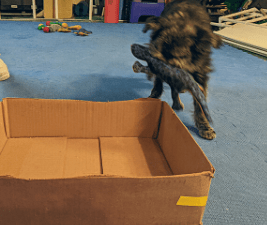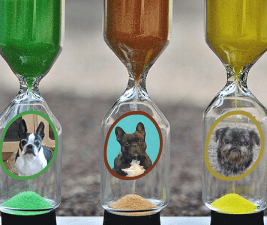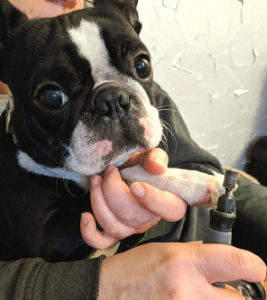Experts recommend that dogs get baths about every one to three months. We got curious about it when we realized that three of our dogs hadn’t had baths in a really long time. We’re not even sure how long it’s been, so we figured it’s about time.
Other than Tango, who gets a medicated bath every week for a skin issue, the other dogs all have short hair. They’re indoor dogs, so the dirt factor is minimal. A couple of years ago Booker (Fran’s 11-year-old Boston Terrier) had a fixation with rolling in dirt in the yard. Fortunately, he seems to have gotten over it. He never did make the connection between “rolling in dirt” and “bath.” The first was always closely followed by the second.
Regular maintenance
While we’re not really conscientious about baths, regular grooming is constantly happening. Brushing happens several times a week, nail-grinding, face-washing, and ear-cleaning are regular Sunday activities. Making it a habit every week means the dogs know what’s coming and are accustomed to it. It also helps that we’ve trained them to accept it. While none of them is crazy about any of it, they tolerate it just fine. The one highlight for the dogs is regular application of coconut oil to their noses. Torque (Hope’s French Bulldog) needs it, the rest just want their turn. It can’t do any harm, so all the lined-up noses get oiled.
Speaking of oils, all dogs have glands that secrete oils onto their skin. Most of these are around the paws, back of the neck, rump, chin, and tail. The stuff they exude, called sebum, is “important for keeping the skin soft, moist and pliable,” according to the Merck Veterinary Manual. What we didn’t know is that “Sebum gives the hair coat sheen and has antibiotic properties.” The “antibiotic” part was news for us. We may use that to justify the lack of baths in their lives.
Not too often
As a matter of fact, bathing your dog too often can dry out the skin and cause flakiness. Brushing distributes the oil through the coat and keeps the dog’s skin and fur in better shape. It doesn’t work for every dog. Fran’s Simon is prone to flakiness despite daily brushing with a rubber curry comb. In addition to brushing, he gets an application of moisturizing lotion while still damp after a bath. You can also combine moisturizer with water in a spray bottle and apply it to your dog’s fur. It has the side benefit of making their fur really soft.
Tango over-produces oils and feels greasy after a few days. The medicated bath helps condition his coat and keeps the greasy feeling at bay. It does absolutely nothing for his disposition, especially since the medicated shampoo has to stay on for 10 minutes. Fran’s knees aren’t crazy about the procedure, either.
Obviously, if/when your dog gets stinky, it’s time for a bath. If you use a flea and tick preventative, be sure to read the instructions. Some recommend waiting a few days after application before you bathe your dog.
Spot cleaning
If your dog is frequently licking their paws or scratching their ears, it may be a sign of allergies. We’ve found it helps to rinse or wipe their paws when they come inside. It only works if your dog has contact allergies, like Torque, who has a mild grass allergy. We keep unscented baby wipes near the door for convenience.
There’s no hard-and-fast rule about how often to give your dogs a bath. We’re going to try to stick to the quarterly plan. But no promises.
Enjoyed this post? Click here to sign up for the weekly newsletter and never miss another!












